PinotFile: 10.11 May 25, 2015
|
Maggy Hawk: Kendall-Jackson’s Crown Jewel of Pinot NoirMaggy Hawk is a gem of a vineyard that rarely comes up in discussion about California’s greatest Pinot Noir vineyards, yet it is the crown jewel among the many acres of vineyards that Kendall-Jackson farms in California. Perhaps its hidden location in the Anderson Valley’s “deep end,” in a rugged and remote outpost that few have ever visited. The map below from WineMaps.com shows the location.
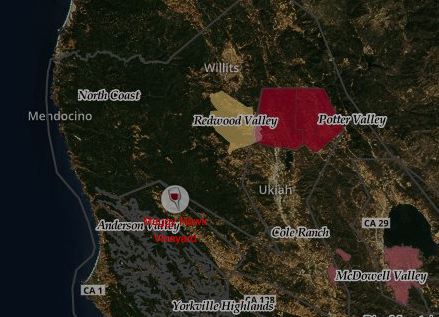 Maggy Hawk is the name of Barbara Banke’s favorite winning thoroughbred horse. Banke was a lawyer and wine connoisseur when she met Jess Jackson and played a major role in the growth of Jackson Family Wines. She assumed the reigns of Jackson Family Wines when Mr. Jackson passed away in 2011. She established the Maggy Hawk label with the inaugural release in 2007. Before that, grapes from Maggy Hawk Vineyard had been an important component of the La Crema Anderson Valley bottling beginning in 2003. This 58.7-acre estate is situated among the coastal redwoods just west of Highway 128. It is a fog-cloaked and wind-swept setting, unique for its complex array of steep slopes and aspects, and well-drained, porous, decomposed sandstone soil. Maggy Hawk winemaker, Elizabeth Grant-Douglas, revers the vineyard property, calling it her “favorite place on earth” and “heavenly.” Maggy Hawk was planted in 2000 to 23.55 acres of distinct blocks with a variety of Pinot Noir clones that include Pommard, Wädenswil 2A, and Dijon 115, 667 and 777, principally on rootstocks 3309C and 101-14. The vine spacing is 8’ x 5’ and 9’ x 5’ with 978 to 1102 plants per acre on a VSP trellis with bilateral cordon. The vineyard manager, Dennis Winchester, lives on the property.
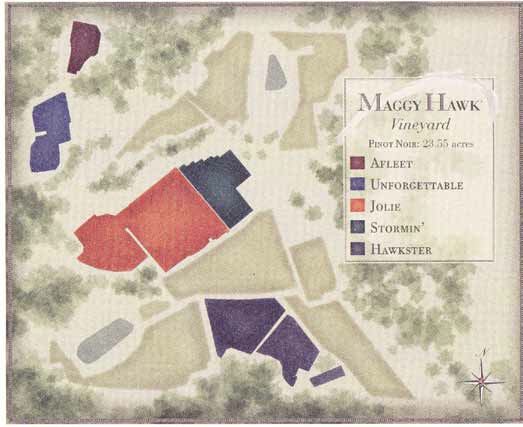 The Maggy Hawk Pinot Noirs are all predominantly single clone bottlings from a specific block within the vineyard and are named after Maggy Hawk’s progeny. Jolie, Afleet, Stormin’ and Unforgettable wines are the offspring of the mare Maggy Hawk and her sire, Hawkster, who also has a Maggy Hawk Vineyard wine named in his honor. Jolie is composed predominantly of Dijon clone 115, Afleet is predominantly Pommard clone, Stormin’ is predominantly Dijon clone 667, as is Unforgettable, but is from 667 grown on the vineyard’s steepest slope, and Hawkster is mainly Wädenswil 2A. I first met with the wines with the 2007 vintage and I commented, “These are truly special connoisseur’s wines that defy appropriate description....possessing a uniqueness and somewhereness that sets them apart.” My tasting of 2011 and 2012 Maggy Hawks Pinot Noirs only reaffirmed my enthusiasm. Maggy Hawk wines are produced in small quantities (a total of less than 1,000 cases) and sold through a mailing list at www.maggyhawk.com. Jolie, Afleet, Stormin’ and Unforgettable are released in the early spring and Hawkster, which is only made in exceptional vintages, is released in the fall. A Maggy Hawk Vineyard Sweepstakes is being offered through June 30, 2015, that includes round trip airfare to San Francisco, CA, a 3-night hotel stay, personal transportation to Anderson Valley and Maggy Hawk Vineyard and dinner vouchers. Visit the winery’s website for instructions on entering (no purchase necessary). 2011 Harvest Notes: Harvest started later than normal and the fruit was picked between October 24 and October 28. The growing season was characterized by heavy spring rains and cooler weather than normal. Yields were lower than average. 2012 Harvest Notes: Nearly a perfect year, the vintage yielded fruit of optimal ripeness while maintaining acidity critical for balance and maturing potential. Grapes were harvested two weeks earlier than in the cooler 2011 vintage. The wines reviewed here from the 2012 vintage are a little better than their 2011 counterparts. The 2011 wines all show more oak overlay. Labels all report 14.5% ABV.
2011 Maggy Hawk Afleet Anderson Valley Pinot Noir 14.8% alc., pH 3.59, TA 0.57, 97 cases, $66. Pommard clone. Aged 14 months in French oak barrels, 34% new. · Moderate reddish purple color in the glass. Lovely aromas of Bing cherry, blackberry, dried herbs and vanilla lead to a mid weight palate of enticing spicy black cherry and raspberry fruit flavors with a thread of herbs and oak vanillin in the background. The tannins are ripe, firm and well-proportioned, the mouthfeel is soft and smooth, and the finish has impressive length. The wine was even better the following day from a previously opened and re-corked bottle with deep cherry flavor and a ridiculously long finish. Score: 92
2011 Maggy Hawk Hawkster Anderson Valley Pinot Noir 15.0% alc., pH 3.69, TA 0.54, 195 cases, $66. Wädenswil 2A clone. Aged 14 months in French oak barrels, 39% new. · Moderately dark reddish purple color in the glass. Very shy aromas of dark cherry and berry with a hint of marzipan and spice. Well-endowed with luscious cherry and berry fruits with a noticeable oak overlay that compliments rather than intrudes. The tannins are modest and supportive, and the finish has a generous richness. Score: 91
2011 Maggy Hawk Jolie Anderson Valley Pinot Noir 14.6% alc., pH 3.59, TA 0.57, 242 cases, $66. Dijon clone 115. Aged 14 months in French oak barrels, 48% new. · Gorgeous moderately dark reddish purple color in the glass. This wine has an “Oh God!” nose offering sexy aromas of Bing cherry, cardamom spice, dark chocolate and vanilla bean. The delicious black cherry core saturates the mid palate, expands in the mouth, and carries over to a finish that seems to last a minute. Suede-like tannins frame the fruit which is accented by oak-driven notes of spice, mocha and vanilla. When tasted the following day from a previously opened and recorked bottle, the aromatic goodness was still in full dress. The only nit I have is that the oak is a little heavyhanded. Score: 93
2011 Maggy Hawk Unforgettable Anderson Valley Pinot Noir 15.1% alc., pH 3.68, TA 0.54, 196 cases, $66. Dijon clone 667. Aged 14 months in French oak barrels, 26% new. · Moderately dark reddish purple color in the glass. The nose leads with effusive aromas of blackberry, boysenberry, cherry, redwood and forest floor. Soft and smooth on the palate with a mid weight array of dark cherry and berry flavors complimented by a savory, “woodsy” tone that is hard to describe but very likable. Oak-driven notes of anise and toast play in the background. Juicy acidity brings the wine on target. Score: 92
2012 Maggy Hawk Afleet Anderson Valley Pinot Noir 14.7% alc., pH 3.63, TA 0.59, 156 cases, $66. Pommard clone. Aged 14 months in French oak barrels, 43% new. · Moderately dark reddish purple color in the glass. Lovely scent of black cherry mash, spice, rose petal and grilled mushrooms. More sappy and concentrated than the 2011 version, with a bombastic array of redder cherry and berry fruits touched by oak. Deft winemaking here with suave tannins, and bright acidity that flatter the fruit core. Like all the 2012 Maggy Hawk Pinot Noirs, the finish is noteworthy for its generosity and persistence. Score: 93
2012 Maggy Hawk Hawkster Anderson Valley Pinot Noir 15.0% alc., pH 3.75, TA 0.54, 268 cases, $66. Wädenswil 2A clone. Aged 14 months in French oak barrels, 63% new. · Moderate reddish purple hue in the glass. A very charming wine that aims to please with inviting scents of dark cherry, spice, rose petal and aniselaced oak. The full-bodied attack of black cherry, black raspberry and blackberry flavors are accented with a hint of spice. The most tannic of the Maggy Hawk Pinot Noirs, but has the fruit concentration to balance. The velvety mouthfeel is very seductive and the head-turning finish ramps up the intensity level a few notches. Score: 93
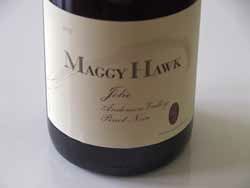 2012 Maggy Hawk Jolie Anderson Valley Pinot Noir 14.9% alc., pH 3.73, TA 0.54, 312 cases, $66. Dijon clone 115. Aged 14 months in French oak barrels, 64% new. · Moderate reddish purple color in the glass. The nose is subdued upon opening, but blossoms over time in the glass to reveal aromas of dark cherry liquor, spice, and plenty of floral goodness including violets and roses. The nose was even more captivating the following day from a previously opened and re-corked bottle and was reminiscent of capturing a whiff of seductive perfume on a beautiful woman. The mid weight plus core of dark cherry and raspberry fruit is incredibly flavorful and reveals many nuances over time including spice, conifer, rosehips tea and just the right touch of oak. Elegant and sleek with amazing length, this wine is the whole package. Compared to the 2011 vintage, this wine is a bit more elegant, more fashionable and shows more adroit oak integration. I have tasted this wine on three other occasions and was blown away each time. An exemplar. Score: 98
2012 Maggy Hawk Stormin’ Anderson Valley Pinot Noir 14.7% alc., pH 3.75, TA 0.54, 223 cases, $66. Dijon clone 667. Aged 14 months in French oak barrels, 41% new. · Moderate reddish purple color in the glass. The nose is more earthy than fruity, with aromas of mulch, mushroom and a hint of blackberry jam. Very soft and silky in the mouth with impressive harmony, this mid weight wine offers layers of sweet dark blackberry, black raspberry and spiced plum flavors accented by complimentary mocha-laced oak. The tannins are satiny and folded in nicely. The fruit intensity builds in the mouth, culminating in an orgasmic finish that never seems to want to go away. Score: 94
Phelps Creek Vineyards: A Unique Burgundian CollaborationRobert Morus founded Phelps Creek Vineyards to focus on estate grown Pinot Noir and Chardonnay. He was raised in the San Francisco Bay Area and experienced the Northern California wine explosion first hand. After serving in the Air Force and becoming a Delta Airlines pilot, he chose to becoming based in Portland, Oregon, hoping to plant a vineyard that was a sensible driving distance away. His first trip to explore the wine districts of Oregon led him to the Columbia Gorge, where he found a 60-acre site perfect for grapevines with a steep southern slope and a magnificent view of the Hood River Valley. He also explored the Willamette Valley but was drawn back to the Columbia Gorge site. After acquiring the property, he would later learn that the Hood River Valley enjoyed the same rainfall (averaging 36 inches of rain annually) and heat as Oregon’s Dundee Hills, although the best vineyard locations for Pinot Noir in the Columbia Gorge sit at a higher elevation. Robert would admit that his planting of Pinot Noir and Chardonnay in the Columbia Gorge was a “lucky, slightly educated guess at the time.”
The visually stunning Columbia Gorge wine region is located less than 60 miles east of Portland, Oregon. Over 30 different grape varieties are grown within this 40 mile stretch of diverse microclimates. The land is defined by the Columbia River as it cuts through the Cascade Mountain Range and makes its journey to the Pacific Ocean. The Columbia Gorge wine region is unique in that it is composed of wineries and growers on both shores of the river in Oregon and Washington. The Columbia Gorge is part of two appellations (AVAs) including the western edge of the Columbia Valley AVA, and encompassing all the Columbia Gorge AVA, which was established in 2004. The Columbia Gorge is a relatively new wine region, long known for pears, apples, cherries and other fruits. It wasn't until the 1970s that growers started planting wine grapes. Currently, over 70% of Gorge-grown grapes are exported to other wine regions in Oregon and Washington. There are now more than 30 wineries and 45+ vineyards dotting the shoreline of the Columbia River in the Columbia Gorge winegrowing region. Relaxed, uncrowded tasting rooms offer a special experience. Visit www.columbiagorgewine.com for a touring map and brochure.
The name of the winery is derived from a tributary of the Columbia River that runs a path just below the Phelps Creek vineyards. The creek is named after Phelps who was a cooper and died in a tragic rafting accident on the Columbia.
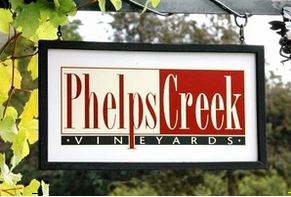 The estate vineyards consist of 30 acres of Pinot Noir and Chardonnay, both self-rooted and grafted plants with initial plantings of Pinot Noir dating to 1990 and Dijon clone Chardonnay in 1992. From the initial 7 acres, planting has incrementally increased, and today there are 25 acres of Pinot Noir (Pommard, Dijon 777 and 115), 4.5 acres of Chardonnay (mostly Dijon 75 and 76 and 200 plants from cuttings of Celilo Vineyard’s Wente clone), and .5 acre of Pinot Gris. Elevation ranges from 950 feet to 1,200 feet (600 feet would be considered high in the Willamette Valley), and soils are primarily volcanic.
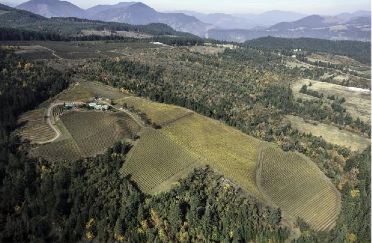 The first harvests went to King Estate and later Ponzi Vineyards, with winemaker Peter Rosback producing a Phelps Creek vineyard-designated Pinot Noir from 2000 to 2006. The first Phelps Creek Pinot Noir started with the 2002 vintage, and by 2007 Phelps Creek kept all estate grapes for their own production. In the same year, Robert met Alexandrine Roy and coaxed her into joining the Phelps Creek team. Alexandrine Roy, who crafts some of the most elegant wines in Gevrey-Chambertain at her family’s Domaine Marc Roy, became a contributing winemaker at Phelps Creek initially, eventually becoming the Director of Winemaking beginning with the 2012 vintage. A fourth generation winemaker, Alexandrine flies to Oregon three or four times a year to oversee the winemaking at the estate. From 2007 through 2011, she primarily made Cuvée Alexandrine, a reserve level Pinot Noir, Fleur de Roy Rosé of Pinot Noir and most recently Coeur de Roy Pinot Noir Blanc. In 2011, wine production was moved to a facility on the estate. Since she took over the reigns, the wines have become spectacular. Photo below is of Alexandrine at a previous IPNC event.
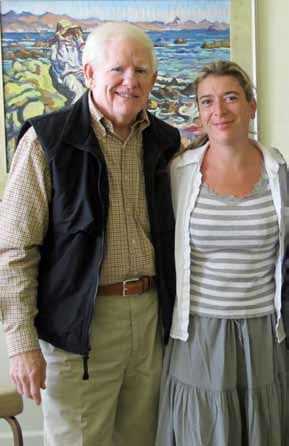 Current production is 5,000 cases annually primarily from estate grown fruit including Pinot Noir, Rosé of Pinot Noir, Chardonnay, Pinot Gris and Pinot Noir Blanc (a Merlot and Syrah are from sourced grapes). The winery’s tasting room is located on the Hood River Golf Course and is open daily. Visit www.phelpscreekvineyards for more information or to order wine. Robert continues his duties as a Captain flying B-777s internationally for Delta Airlines, and his daughter, Becky, has joined the team as Operations Manager and his son, Toby, as Hospitality Coordinator.
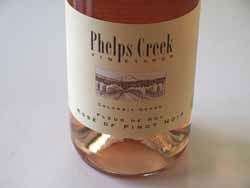 2014 Phelps Creek Vineyards Fleur de Roy Columbia Gorge Oregon Rosé of Pinot Noir 13.5% alc., 120 cases, $26, screwcap. Clone 115. A saignée from estate grapes picked early made in the fashion that winemaker Alexandrine Roy employs for her rosé at home in Gevrey-Chambertain. Fermented in neutral French oak barrels. · Moderately light salmon color in the glass. This is an exceptional rosé that leads with scents of fresh strawberries and peaches that really draw you into the glass. Crisp, with bright flavors of strawberry, pear and apricot, the wine wraps the palate in fresh fruit flavors, and leaves on impression on the uplifting finish. Straight and true, this wine is among the best that Oregon has to offer. Score: 92
2014 Phelps Creek Vineyards Le Petit Columbia Gorge Oregon Pinot Noir 12.6% alc., TA 0.65, 238 cases, $28, screwcap. Estate grown Pinot Noir. A Cru Beaujolais style wine incorporating whole cluster, carbonic fermentation. Dijon clone 115. Harvest Brix 22.8º. Aged in stainless tank. · Light cherry red color in the glass. Heady scents of strawberry, cherry, cake spice and floral bouquet lead to a light weight, pleasant wine that is easy to like. Spirited by red berry flavor and a cranberry-laced finish, this wine has refreshingly crisp acidity. Serve slightly chilled. Score: 87
2013 Phelps Creek Vineyards Columbia Gorge Oregon Pinot Noir 13.4% alc., 1,204 cases, $34. Estate grown. Clones are Pommard, Dijon 115 and 777. Harvest Brix 23.7º. Aged in French oak barrels, 10% new Cadus. · Moderate light cherry red color in the glass. Nicely appointed nose with aromas of cherry spice, sousbois and black tea. Soft and smooth in the mouth, with straightforward flavors of cherry and raspberry framed by modest tannins. A solid everyday drinker. Score: 88
2013 Phelps Creek Vineyards “Regina” Columbia Gorge Pinot Noir 13.5% alc., 93 cases, $49. The finest 4 barrels of Pommard clone in the cellar. Oldest plantings of self-rooted vines. Named in honor of owner Robert Morus’ mother. Harvest Brix 23.7º. Aged in French oak barrels, 25% new. · Moderately light reddish purple hue in the glass. Engaging aromas of Bing cherry, dark red rose and spice. Plenty of Pinot singing in this wine with a delicious core of Asian-spiced cherry goodness complimented by subtle oak. Very suave and elegant with a markedly intense and lengthy finish that sports some ripe fruit tannins that offer textural interest. Extremely giving and enjoyable now. Score: 93
2013 Phelps Creek Vineyards Cuvée Alexandrine Columbia Gorge Oregon Pinot Noir 13.5% alc., 244 cases, $54. The winery’s flagship wine consisting of 10 barrels carefully selected from the estate vineyards by winemaker Alexandrine Roy. Pommard and Dijon 115 and 777. Harvest Brix 23.8º. Native yeast fermentation, aged in French oak barrels, 25% new Cadus. · Moderately light reddish purple color in the glass. An earthy, savory nose with hints of black cherry, BBQ spice, tobacco and oak. Quite elegant on the palate with a deep black cherry flavor accented with dried herbs and anise-laced oak. Very charming now, but not fully expressive, and more giving the following day from a previously opened and re-corked bottle. I would cellar a year or two. Do I dare say, “Burgundian?” Score: 92-93
 2010 Phelps Creek Vineyards “Beehive” Columbia Gorge Oregon Pinot Noir 13.4% alc., TA 0.62, 80 cases, $54. The Beehive Block is south of the original estate vineyard planting, the site of abandoned commercial beehives on a field when the property was acquired. The clone 777 planted here has extraordinary character in cooler years like 2010. Harvest Brix 23.6º. A 3-barrel selection were aged in once-used French oak barrels for 24 months. · Medium reddish purple color in the glass. Unrelenting aromas of black cherry, spice, and potpourri. Wow! Terrific attack and finish with wondrous harmony and finesse, featuring delicious mid weight flavors of black cherry, black raspberry and spice. A stunning wine that has an earthy vein in the background and is not simply fruity. This wine is currently drinking at is apogee. Score: 95
Sips of Recently Tasted California Pinot NoirRead carefully as there are some real gems in this issue. I would be perfectly happy the rest of my life if my cellar was only stocked with these wines.
Philip Krumal and partner Michael Dilsaver farm a vineyard high on a ridge overlooking the Pacific Ocean in Atascadero at the southern end of the Santa Lucia Mountains. The 300-acre property includes a B&B inn. The 7-acre vineyard was established adjacent the inn on a well-drained hillside at 2,200 feet elevation. Several Pinot Noir clones are planted including Pommard 4 and 5, Wädenswil 2A, 23, Dijon 667 and 777, and an HMR selection. Philip learning his viticulture and winemaking primarily from Marc Goldberg of nearby Windward Vineyard and continues to rely on Marc as a consultant. These two wines are the best I have ever tasted from this property. Visit www.asuncionridge.com.
2012 Asuncion Ridge Vineyards San Luis Obispo County Pinot Noir 14.9% alc., 163 cases, $38. · Moderately dark reddish purple color in the glass. Aromas of black raspberry, forest floor and nutty oak unfold slowly in the glass. Delicious mid weight plus core of well-ripened dark berry fruits with a supportive note of oak. The fruit really sparkles with an aggressive mid palate attack and expansive finish. Modest tannins allow for enjoyment now, although this wine was even more enjoyable the following day from a previously opened and re-corked bottle. Score: 92
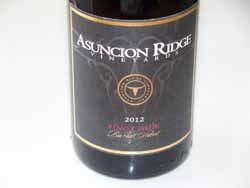 2012 Asuncion Ridge Vineyards San Luis Obispo County Barrel Select Pinot Noir 14.8% alc., 54 cases, $58. 100% free-run juice from all vineyard clones but mainly Pommard and 115. · Moderately dark reddish purple color in the glass. Don’t even think about drinking this wine now without decanting. When tasted a day after opening from a decanted bottle, the wine was glorious with hi-tone aromas of dark berries and spice. Robust, yet velvety on the palate, with waves of boysenberry, blackberry, cola and exotic spice flavors that are perfectly complimented by oak. Beautifully balanced, with amazing fruit expression only possible in California. This special wine will excel with even more over time in the cellar. Score: 94
Winemaker Ross Cobb is a Pinot Noir specialist producing superb wines from small, carefully chosen vineyards in the West Sonoma Coast region. His experience at Williams Selyem and Flowers Winery led him to found COBB Wines in 2008 at a time when he left Flowers and became the winemaker for Hirsch Vineyards. He assisted his father in farming the 15-acre Coastlands Vineyard and managed all other vineyards from which he sourced grapes. Ross picks at modest Brix levels, employs whole cluster fermentation, and ferments with native yeasts. The 2012 vintage provided some of the most generous wines Ross has ever made. Visit www.cobbwines.com. At Ross’s request, I decanted the following wines 3 hours before tasting and repeated my tasting the following day. These three wines are among the finest I have ever sampled from COBB.
 2012 COBB Diane Cobb: Coastlands Vineyard Sonoma Coast Pinot Noir 14.1% alc., 225 cases, $85. A cofermentation of 18 to 20 different Pinot Noir selections from Diane Cobb’s nursery block of dry-farmed, own-rooted vines that are among the oldest in the region. Seventh vintage. 40% whole clusters. Aged 22 months in French oak barrels, 40% new. · Moderately dark reddish purple color in the glass. Deep, penetrating scents of cherry, black raspberry, spice, rose petal and humid bark. Ever-expanding flavors of black cherry, grenadine, black raspberry, and Asian 5-spice that saturate every nook and cranny in the mouth. Impeccable harmony with supportive fine-grain tannins, and a huge, peacock tail finish that is stunning. I was at a loss for more superlatives the following day when tasted from a previously opened and re-corked bottle when the arsenal of aromas and flavors were entirely seductive. Score: 97
2012 COBB Emmaline Ann Vineyard Sonoma Coast Pinot Noir 12.5% alc., 175 cases, $75. This Freestone Valley vineyard gets the most shade and fog of any of the vineyards winemaker Cobb works with. 30% whole clusters. Aged 22 months in French oak barrels, 30% new. · Moderately light reddish purple color in the glass. A loud nose of ever-expanding aromas of cherry, raspberry, rose petal, spice and sandalwood. Lighter in weight and quite demure, but very flavorful, with tastes of cherry, strawberry, spice and floral goodness, framed by suave tannins and lifted by a bright spark of acidity. A lengthy finish completes the deal. Even more whole cluster evident the following day from a previously opened and re-corked bottle. Score: 93
2012 COBB Rice-Spivak Vineyard Sonoma Coast Pinot Noir 12.5% alc., 225 cases, $75. Dijon and Swan selection plantings in Goldridge soil. Aged 22 months in French oak barrels, 22% new. · Medium reddish purple color in the glass. Perfumed and sensuous, with aromas of Bing cherry, plum, spice, rose petal and smoky oak. Light to mid weight cornucopia of succulent cherry, strawberry, and blueberry fruits with a vein of citrus in the background and exotic edges to the experience. Exemplary roundness, with supple tannins, a silky mouth feel, and a refreshing grip on the finish which offers flavor and cut. When tasted the following day from a previously opened and re-corked bottle, the aromas were still heavenly, and the finish had picked up steam. Brilliant! Score: 95
Proprietor and winemaker Kathleen Inman crafts Pinot Noir, Rosé of Pinot Noir, Chardonnay, Pinot Gris, and sparkling wines from the heart of the Russian River Valley. Since planting the 10.45-acre Olivet Grange Vineyard in the Middle Reach area of the Russian River Valley in 2000, she has built one of the greenest wineries in Sonoma County, using recycled materials for construction, recycling all waste water, and relying on solar power. Since the 2009 vintage, she has incorporated more whole clusters in her ferments, and always strives for balanced wines with moderate alcohol and vibrant natural acidity. She has been a long time proponent of screwcap closures. The estate and tasting room is located at the junction of Piner and Olivet Road in Santa Rosa. Visit www.inmanfamilywines.com.
2013 Inman Family Russian River Valley Chardonnay 12.2% alc., 515 cases, $35, screwcap. Sourced from Pratt-Irwin Lane Vineyard. Harvest Brix 21.5º. Whole cluster pressed, cold settled, and sent to a combination of 40% new French oak barrels and 60% to small stainless steel barrels. Lees stirring weekly until malolactic fermentation completed, and monthly thereafter. Native yeast and bacteria fermentations, 100% malolactic fermentation. · Light golden yellow color in the glass. A Chablis-styled wine that shows modesty and restraint. Aromas of lemon, crème brûlée, and almond spread lead to a crisp, clean and uplifting flavors of green apple, lemon, Asian pear and the faintest kiss of oak, finishing with a burst of refreshing, lemon-lime driven flavor that persists. Score: 92
2012 Inman Family Thorn Ridge Ranch Russian River Valley Pinot Noir 13.7% alc., 226 cases, $56, screwcap. Sourced from Ted Klopp’s ranch in the Sebastopol Hills with vines planted in Goldridge soil. Pommard and Dijon 777 clones. Last wine from this vineyard source. Native yeast and bacteria fermentations. 100% de-stemmed, 4-day cold soak, native yeast and bacteria fermentations. Aged 11 months in French oak barrels, 25% new. Gently filtered by crossflow. · Light cherry red color in the glass. Plenty of interest on the nose with scents of black cherry, blackberry, dried herbs, earth, tar and wood cask. The flavors of dark cherries and berries are accented with notes of game and tarry oak. Silky in the mouth, with modest tannins and some noteworthy finishing power. Score: 91
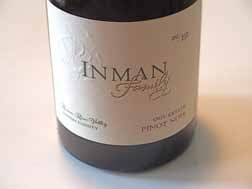 2012 Inman Family Olivet Grange Vineyard Russian River Valley Pinot Noir 13.6% alc., pH 3.65, TA 0.51, 825 cases, $63, screwcap. Grapes are from the estate OGV Vineyard that is organically farmed. Clones 114, 115, 667, 777 and “828.” Over 50% whole clusters, native yeast and bacteria fermentations. Aged 22 months in primarily Sirugue French oak barrels sur lie with regular stirring. · Moderately light reddish purple color in the glass. The nose brings a pleasing smile with hi-tone aromas of Bing cherry, baking spice, and rose petal. Vigorous on the attack, with delicious flavors of cherry, strawberry, cola, earthy flora, and spice. Silky and elegant on the palate, with modest tannins, balanced acidity, and a finish consumed by intense cherry goodness. Score: 93
Ryan Cochrane learned his winemaking at the hand of Roger Nicolas of RN Estate in Paso Robles. He crafted his first barrel of Pinot Noir in 2010 and has gradually increased his production since. The 2012 wines were previously reviewed about a year ago and have improved noticeably since then (I did not look at my previous 2012 reviews before this tasting to eliminate any bias). The website is www.ryancochranewines.com.
2012 Ryan Cochrane Fiddlestix Vineyard Sta. Rita Hills Pinot Noir 14.5% alc., 134 cases, $43. 75% Dijon 115, 25% Pommard 5. 30% whole cluster fermentation. Aged 10 months in French oak barrels, 20% new. · Moderate reddish purple color in the glass. A bit brooding initially, reluctantly offering aromas of dark berry fruits, rose petal and oak. The succulent, mid weight plus blackberry and boysenberry fruits flood the mouth with sweet, sappy goodness, carrying over to a luscious finish offering citrus-laced berry fruits. The most concentrated and darkest fruited of the four Pinot Noirs tasted here with the most intensity on the finish. The wine becomes more appealing over time in the glass and showed better oak integration the following day from a previously opened and re-corked bottle. Decant if you drink now, but better to give this beauty another year or two in bottle. Score: 91
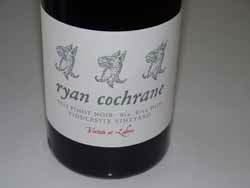 2013 Ryan Cochrane Fiddlestix Vineyard Sta. Rita Hills Pinot Noir 14.0% alc., 125 cases, $43. 75% Dijon 115, 25% Pommard 5. 20% whole cluster fermentation. Aged 10 months in French oak barrels, 20% new. · Moderately light reddish purple color in the glass. More red-fruited in this vintage, offering scents of strawberry, cherry and sandalwood. Appealing elegance on the palate, with a vibrant array of red cherry and red berry flavors. The tannins are folded in nicely, there is inviting underlying acidity, the oak plays a complimentary role in the background, and the long red cherry finish grabs your attention. A completely different wine than the 2012 vintage offering, but equally enjoyable for its pinot character. Score: 91
2012 Ryan Cochrane Solomon Hills Vineyard Santa Maria Valley Pinot Noir 14.2% alc., 143 cases, $43. 50% Dijon 115, 50% Pommard 5. 30% whole cluster fermentation. Aged 10 months in French oak barrels, 25% new. · Moderately light reddish purple color in the glass. Shy aromas of dark cherry, baking spice and tobacco become more effusive over time in the glass. Very elegant, with mid weight flavors of cherry, Damsel plum, and tobacco at play. Modest tannins, with vivid finishing acidity. This wine charms with finesse. Score: 90
2013 Ryan Cochrane Solomon Hills Vineyard Santa Maria Valley Pinot Noir 14.2% alc., 392 cases, $43. 33% Dijon 115, 33% Dijon 667 and 33% Pommard 5. 30% whole cluster fermentation. Aged 10 months in French oak barrels, 25% new. · Moderately light reddish purple color in the glass. This wine sports a little more concentration, roundness and polish than the 2012 version. Aromas of cherry, red berry and toasty oak become more giving over time in the glass. Smooth and debonair on the palate, with a middleweight core of ripe black cherry fruit that is juicy and persistent. The tannins are supple, their is lively supporting acidity, and the cherry-fueled finish is uplifting. Score: 91
2013 Ryan Cochrane Solomon Hills Vineyard Santa Maria Valley Chardonnay 14.0% alc., 125 cases, $34. Wente clone 4. Native yeast fermentation, 100% malolactic fermentation. Barrel fermented and aged 10 months in French oak barrels, 40% new. · Moderately light golden yellow color in the glass. The nose is very charming, with pleasing aromas of lemon peel, brioche and vanilla pastry creme. Flavors of lemon, Asian pear, white peach and subtle vanilla are accented with a saline minerality. Nicely balanced with adept integration of oak, and thirst-quenching acidity on a finish that has some persistence. Score: 92
2013 Kendall-Jackson Grand Reserve California Pinot Noir 14.5% alc., pH 3.73, TA 0.50, 6,415 cases, $26. 66% Monterey County and 34% Santa Barbara County Jackson Estates fruit. A potpourri of mountain, ridge, hillside and benchland grapes. Crafted from the top 7% of Kendall-Jackson lots. 70% of the wine is from the same vineyard blocks each year ensuring greater consistency. Aged 9 months in predominantly French oak barrels. · Moderate reddish purple hue in the glass. Exuberant aromas upon opening of black cherry, strawberry, clove and forest floor which fade a bit over time in the glass. A cherry-themed wine of good richness with a pleasing compliment of spice and oak. A forward, easy drinking wine. Score: 87
2013 Kendall-Jackson Jackson Estate Anderson Valley Pinot Noir 14.5% alc., TA 0.60, 3,445 cases, $30. Released March 2015. Aged 9 months in 71% French oak (40% new) and 29% American oak. · Moderate reddish purple color in the glass. Oak-driven aromas of smoke, mocha and vanilla side with black cherry fruit. Mid weight ripe fruit flavors of black cherry and black raspberry are strongly accented with cola and vanilla. Well-structured, with balancing acidity, and some finishing intensity. Score: 88
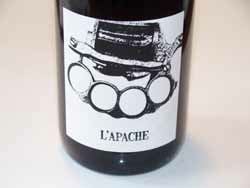 2013 Olsen Perri Wines L’Apache Santa Barbara County Pinot Noir 13.4% alc., pH 3.68, TA 0.60, 92 cases, $45. A selection of the best 4 barrels of the 2013 vintage. The name gets its inspiration from a violent but colorful Paris street gang from the late 1800s known as the Apache (“a-posh”). Grapes were sourced from Hilliard Bruce Vineyards, Bassi Ranch and Pence Ranch. Clones 777 and Pommard. Minor stem inclusion, cool native fermentation in small batches, pressed with a basket press and moved to French oak barrels, 50% new, where it was aged for 10 months. Unfined and unfiltered. · Moderate reddish purple color in the glass. Aromas of darker red berries and cherries, green herbs and oak. The fruit flavors of black cherry and black raspberry are overlain with an earthy, herbal tone and plenty of toasty oak. The tannins are nicely folded in and the finish is quite juicy. There is too much oak at play for my personal taste at present, but this may mitigate some over time in bottle. Score: 88
Wine as Part of a Healthy Lifestyle: 2014 in ReviewIn the February 8, 2015, issue of the PinotFile, I started the first in a series of articles on “Wine as Part of A Healthy Lifestyle: 2014 in Review.” Each year, it is customary for me to offer a summary of major scientific studies published in the preceding year. As a retired physician, and believer that wine in moderation plays an important role in a healthy lifestyle, I have a dedicated interest in studies that contribute to our current understanding of the roles that alcohol and wine play in our health. I believe it is important to accurately communicate the possible health benefits of drinking wine in moderation. The possible health benefits of alcohol and wine are hotly debated in the lay press. Articles appear with disparaging titles like, “Too Good To Be True,” “Can Wine Be Good for You?,” “No Amount of Alcohol is Safe,” and “Bad News if You Think Wine is Healthy.” The National Institute for Health & Care Excellence (NICE) in the UK even went so far as to proclaim in 2014, “Those who drink a couple of large glasses a wine a day are ‘mild alcoholics.’” The International Agency for Research on Cancer (IAVR) has labeled alcoholic beverages as “carcinogenic to humans,” and placed them in a group alongside ultraviolet light and chronic infection with hepatitis B. Voices of opposition include The International Scientific Forum on Alcohol Research that objected to IAVR’s stance, emphasizing the distinction between excessive alcohol use and moderate drinking. The American Institute for Cancer Research does not even mention alcohol in its latest cancer-prevention campaign, noting that changes in diet, weight and physical activity are the most important preventive lifestyle changes. American pathologist, Emanuel Rubin, M.D., wrote in Alcoholism: Clinical & Experimental Research online in January 2015, “Doctors should tell lifelong abstainers to start having a drink with dinner every night. The overwhelming evidence suggests that physicians should counsel lifelong non drinkers at about 40 to 50 years of age to relax and take a drink a day, preferably with dinner.” Such a bold statement may be sound advice, but it is controversial and most researchers are hesitant to support such a recommendation. Dr. Kari Poikolainen, a former alcohol expert for the World Health Organization, has written a book titled, Perfect Drinking and its Enemies.” He is a firm believer that drinking, be it wine, beer, liquor, water, coffee or tea, is essential to health. He has examined decades of research on wine and concludes, “The weight of evidence shows moderate drinking is better than abstaining and heavy drinking is worse than abstaining. However, moderate amounts of drinking can be higher than guidelines say (up to a bottle a day may not be bad for you).”
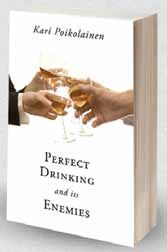 Curtis Ellison, M.D., Professor of Medicine & Public Health at the Boston University School of Medicine in Boston is an outspoken and well-respected researcher who is a proponent of the health benefits of drinking in moderation. He responded to a July 15, 2014, column written by James Laube in the Wine Spectator on the French Paradox. Ellison said the following. “Since the public learned about the paradox from Morley Safer in 1991, there have been literally hundreds of large-scale, prospective studies of the relation of wine and alcohol to the risk of developing heart disease. In studies from all over the world, moderate drinkers, especially those who predominantly chose wine, have 20 percent to 30 percent lower risk of having a heart attack.” Ellison went on to say, “In addition, moderate drinking has been shown to have a protective effect on the other of the ‘diseases of aging.” For example, the risk of stroke and diabetes is clearly lower among moderate drinkers. And increasing evidence is demonstrating a lowered risk of developing Alzheimer’s disease and other types of dementia among drinkers. While many of these studies show greater protection from red wine, it has been well demonstrated that white wine, beer and other beverages containing alcohol also help protect against these diseases. Thousands of animal and human experiments have identified the biologic mechanisms for such an effect: these include protective influences on blood HDL-cholesterol, other lipids, clotting factors, inflammation, glucose metabolism and vascular function.” The bottom line, Ellison proclaims, is, “For middle-aged and older people essentially all well-done studies continue to support beneficial health effects of wine when consumed in a sensible fashion: small amounts (say, a couple of drinks per day), consumed every day, and especially with meals.” The exact point where drinking ceases to be beneficial is unclear but the preponderance of science would suggest that it is above 2 standard glasses of wine a day (a standard glass is 5 ounces of 12% alcohol wine) for men and 1 standard glass of wine a day for women, the current standard definition of moderate drinking and what is considered safe, healthful consumption by the Department of Agriculture and Department of Health & Human Services, and the American Heart Association.
Drinking in ModerationDrinking in moderation can be challenging since the ingestion of alcohol leads to alcohol in the bloodstream and the release of the “feel good” neurotransmitter involved in reward-motivation behavior in the brain called dopamine. Alcohol is a rewarding experience that increases the level of dopamine in the reward pathway in the brain, potentially leading to more drinking, binging and even alcohol dependence. Fortunately, most of us realize the difference between moderate drinking and excessive drinking and do not have a need to obsess about how to enjoy alcohol. Researchers at Iowa State and Cornell University reported in the International Journal of Drug Policy in November 2014 suggested pouring a half of glass of wine no matter the size of the glass to prevent drinking too much. Using this “half glass” rule-of-thumb reduced the volume poured by more than 20% for men and women, and substantially reduced the pour by men with high Body Mass Index (BMI) levels who tend to over pour. The study also found that individuals who drank from wider glasses poured themselves 11.9 percent more wine than those who had smaller glasses. The researchers concluded, “Free pouring wine increases the tendency to over consume because it is not as easily measured as other types of alcohol beverages such as beer or spirits. Glasses make a difference when determining whether you are drinking in moderation. A major study by the Organization for Economic Co-Operation and Development (OECD) found that four in five drinkers would live longer if they cut their alcohol intake by just a glass of wine a week. Between 78 percent and 83 percent of all drinkers studied could reduce their annual risk of death from all causes by having just one less unit (or standard drink) per week. Matthew Doran reported a story at www.abc.net.au/world/today titled “Rise in Wine Alcohol Levels.” The point was that the alcohol content of wine produced around the world has increased over the last 20 years according to data analyzed by Professor Alston from the Robert Mondavi Institute for Wine Economics at the University of California. The trend amounted to about 10% increase for the world as a whole. The result is that people may be drinking more alcohol per glass of wine than they think. Vive, a wristband prototype developed by students at the University of Washington, can detect alcohol levels in the blood and make the wearer check in by vibrating and forcing the wearer to squeeze the device to indicate they are conscious. Check-ins become more frequent as alcohol levels rise. The idea was praised by Microsoft and won “Best Product” at a Microsoft design invent. Drinkaware in the UK launched a free smartphone App that is designed to allow people to monitor their alcohol consumption. It allows users to monitor moderate drinking by offering graphs to show daily, weekly or monthly alcohol consumption related to health risk levels. The App is available from the App Store. For more information on moderate drinking, visit www.drinkinmoderation.org. This site includes information on alcohol and health, standard drink definitions, and the U.S. Dietary Guidelines for Americans.
Binge DrinkingBinge drinking is a confusing and imprecise term since it is defined in several different ways. It is also interchanged with the terms “excessive” and “heavy” drinking. The National Institute on Alcohol Abuse and Alcoholism defines binge drinking as a pattern of drinking that brings blood concentration (BAC) levels to 0.08 g/dL which is also the legal limit for driving. This typically occurs after 4 drinks for women and 5 drinks for men in about 2 hours. The Substance Abuse and Mental Health Services Administration defines binge drinking as drinking 5 or more alcoholic drinks on the same occasion on at least 1 day in the past 30 days. The World Health Organization defines binge drinking as consuming more than 6 units of alcohol (2 175 ml or 6 ounce glasses of wine) on one occasion. According to the Centers for Disease Control and Prevention (CDC), one in six adults in the U.S. binge drink four times a month. The CDC’s fact sheet on excessive drinking is below. Regardless of how you define binge drinking, it is clearly hazardous to your health.
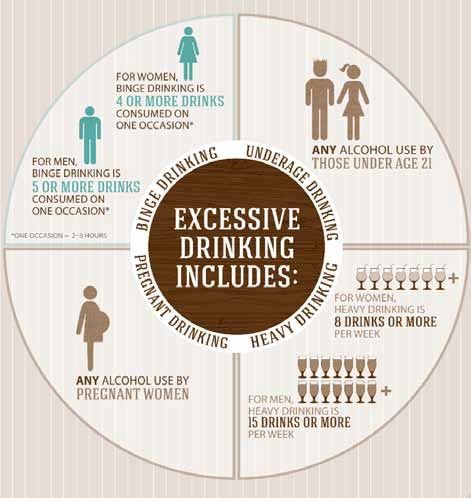 The journal Preventing Chronic Disease reported in June 2014 that excessive alcohol use and binge drinking has led to a death toll just shy of 88,000 people per year in the U.S., 70% of which were men. Binge drinking was responsible for more than half of the deaths. Worldwide figures indicate 16% of the population binge drink. A University of Massachusetts Medical School study funded by NIH and published in PLOS ONE online May 14, 2014, looked at the effects of acute binge drinking in healthy adults on serum endotoxin levels. Previous studies have demonstrated that chronic alcohol use results in increased gut permeability and increased serum endotoxin levels that contribute to many of the biological effects including alcoholic liver disease. This study found that acute alcohol binge result in a rapid increase in serum endotoxin and bacterial DNA levels in the bloodstream. Compared to men, women had higher blood alcohol and circulating endotoxin levels. The biological significance of the in vivo endotoxin elevation was accompanied by increased levels of inflammatory cytokines. The findings indicate that even a single alcohol binge results in increased serum endotoxin levels likely due to increased gut permeability and disturbs innate immune responses that can contribute to the deleterious effects of binge drinking. Alcohol binge is more dangerous than previously thought and has significant health effects even in healthy individuals. A report in the journal Alcohol: Clinical & Experimental Research detailed a study that found among older moderate drinkers, periodic heavy drinking showed a significantly increased total mortality risk compared to regular moderate drinkers. Moderation was defined as no more than one-half a drink per day for women and no more than two drinks per day for men.
Red vs White WineBoth red and white wine have the same amount of carbohydrates and calcium, with red wine having slightly more calories than white wine. Unique to red wine are iron, magnesium, phosphorus, potassium, choline and a much higher concentration of polyphenols, organic compounds found in the skins and seeds of grapes that research has shown to provide several potential health benefits. Resveratrol is the best-known and most studied phenolic compound. One glass of red wine has 200 mg of polyphenols compared to 40 mg for white wine because red wines are macerated on their skins, the source of polyphenols. Champagne, however, has been shown to contain relatively high amounts of phenolic acids. Although moderate consumption of red wine is thought to be healthier as a result, the alcohol in both red and white wines itself confers health benefits on imbibers such as reducing the risk of heart disease and stroke. Recent research in Italy published in PLOS ONE online has suggested that white wine may be as healthy as red wine. This study focused specifically on the polyphenol caftaric acid that is found in both red and white wines and is a powerful antioxidant that may have resveratrol-like effects. The results showed that caftaric acid improved the health of arteries by increasing the availability of the vasodilator nitric oxide in lab mice. The researchers theorized that the antioxidant property of caftaric acid might explain the potential cardiovascular protection resulting from moderate white wine consumption as part of a typical Mediterranean diet. White wine may have been given a bad rap, so don’t avoid a glass of your favorite Chardonnay for fear that it isn’t as “healthy” as a glass of red wine. My advice for white wine aficionados: chill, open, and chill.
Wine as Part of Mediterranean DietThe well-known and researched Mediterranean diet is based on eating primarily plant-based foods including fruits, vegetables, whole grains, legumes and nuts, and replacing butter with olive oil, and using herbs and spices instead of salt to flavor foods. It favors fish and poultry over red meat, and includes the moderate consumption of red wine. The diet was inspired by the dietary patterns that are traditional in the countries of Greece, Southern Italy and Spain. Its health benefits are many including reduced levels of inflammation, a risk factor for cardiovascular disease, stroke and Alzheimer’s disease, and a decreased risk of diabetes. A study published in Microvascular Research on the long-term effects of exercise and Mediterranean diet intervention on the vascular function of an older (55 and over), healthy population, showed that both the exercise and Mediterranean diet groups had improvements in microvascular outcomes compared with baseline, but the highest improvement was in the group that combined exercise and the Mediterranean diet. A collaborative study by researchers at the University of Miami Miller School of Medicine looked at a group of 1,937 multiethnic patients and determined what type of diet they regularly consumed as well as the mass of their left ventricle using echocardiography. It is known that increased left ventricular mass is a risk factor for cardiovascular disease in many populations. The study found that those adhering to the Mediterranean diet had smaller left ventricular masses than those not following the same diet. After controlling for demographics, behavioral risk factors, diabetes, BMI, height and blood pressure, left ventricular mass was still significantly less in those adhering to a Mediterranean-style diet compared with those that did not. Those with greatest adherence to the Mediterranean diet had the smallest left ventricular masses. Despite the need for further research, this important study indicates that the Mediterranean diet plays a significant role in maintaining good cardiovascular health. A study by Italian researchers published in the Journal of the American Society of Hematology in March 2014, found that adherence to the Mediterranean diet is associated with lower levels of inflammation markers that are linked with increased risk of coronary heart disease. Both platelet and white blood cell counts, markers of inflammation that have been linked to cardiovascular disease, were monitored in 14,586 individuals in Italy. Individuals who had a high adherence to the Mediterranean diet had lower levels of platelet and white blood cell counts compared to those with lower adherence rates. Dietary antioxidants such as those found in olive oil, wine, vegetables and dietary fiber partially accounted for this association. Research published in the journal Public Health Nutrition studied 760 non fatal heart attack patients admitted to hospitals in Italy and compared them to 682 patients admitted to the same hospitals for reasons other than cardiovascular disease as controls. Adherence to the Mediterranean diet was determined by interview for each study participant. The results showed that a higher adherence to the Mediterranean diet was associated with a lower risk of non fatal heart attack in Italian adults and eating vegetables and beans was the most significant factor contributing to this reduced risk. Another Italian study published in the European Journal of Preventive Cardiology looked at the relationship between adherence to the Mediterranean diet and mortality in individuals with diabetes. Overall, those who adhered to a Mediterranean diet had a reduced risk of death. The specific factors in the Mediterranean diet that were thought responsible for this decreased risk of death in patients with diabetes were moderate alcohol consumption, high consumption of cereals and vegetables, and reduced consumption of meat and dairy products. For updates on the science behind the Mediterranean diet and health, visit the blog at www.french-paradox.net. Titled “The French Paradox: The Science Behind the Mediterranean Diet and Your Health,” this blog is coauthored by Becca L. Yeamans-Irwin, a biomedical scientist, and Lewis Purdue, who has an academic background in biology, organic chemistry, environmental science and nuclear engineering.
General Health Benefits of WineThe apparent health benefits of low to moderate drinking of wine are many. Higher levels of drinking are linked to many health risks and cancel out all the health benefits. Peer-reviewed, scientific research suggests the following health benefits of moderate wine consumption: 1 Reduction in the risk of coronary heart disease and heart attack and a lower mortality rate in those who have had a heart attack. The heart healthy benefits of wine may be due at least in part to increases in good cholesterol (HDL). 2 Reduction in blood pressure. 3 Longevity. 4 Less likely to develop dementia, especially Alzheimer’s. 5 Lower risk of becoming overweight. 6 Lower risk of stroke, particularly in women. 7 Lower risk of adult-onset diabetes type 2 8 Decreased risk of osteoporosis and possible decreased risk of rheumatoid arthritis in women 9 Decreased risk of depression 10 May increase performance on cognitive function tests including memory. 11 Regular red wine drinkers have higher levels of testosterone, which increases the libido in both men and women. 12 Resveratrol in red wine can fight fat buildup in the liver, reducing the risk of liver failure. 13 Red wine has been shown to bolster the cancer-fighting powers of antioxidants, aid good bacteria in the digestive system, and help prevent colon cancer. 14 The anti-inflammatory properties of phenols and flavonoids in both red and white wines can bolster collagen and help delay wrinkles. 15 Drinking red wine deters bed bugs from biting. 16 Drinking in moderation may reduce hearing loss in women. The negative health consequences of drinking alcohol in moderation include an Increased risk of certain cancers such as the mouth, esophagus, larynx, pharynx and breast. Moderate alcohol consumption has also been shown to significantly increase the intake of high fat and savory foods. Chicago researchers studied a multiethnic sample of middle-aged, healthy women. Consumption of wine was stable and common with 20% reporting none, 69% light (<1 drink per day), 7% moderate (1 drink per day) and heavy (>1 drink per day). To guard against underreporting, the researchers took the maximum reported wine consumption over 7 years as the predictor. Moderate wine consumers had significantly lower levels of Creactive protein and plasminogen activator inhibitor than women that drank little or no wine. This would indicate that moderate wine consumption may protect against cardiovascular disease via inflammatory and clotting pathways. A study from the University of Gothenburg in Sweden published in late October 2014 in the journal Alcohol suggested that the protective effects of alcohol are present only if you have a certain genetic makeup. Only 15 percent of the population have this genetic makeup (the CETP Taq1B gene). The CETP gene regulates the transport of cholesterol from the peripheral arteries to the liver and this reduces the risk of coronary artery disease. Researchers examined the genomes and compared the drinking habits of two randomly sampled groups that included 618 with coronary artery disease and a control group of 2,921 people. The fortunate people with a CETP gene variation showed a strong link between a lower risk of coronary artery disease and moderate alcohol intake. A previous 1995 study found the same link between moderate alcohol consumption, cardiovascular disease and this specific genotype.
CancerOne of the most respected researchers in alcohol and cancer, Dr. Arthur Klatsky, published a study in 2014 online in Cancer Causes Control titled, “Moderate alcohol intake and cancer: the role of underreporting.” He looked at a large cohort of more than 125,000 people and controlled for seven covariates. Persons reporting light to moderate drinking had an increased risk of cancer in this cohort with more risk in the group suspected of underreporting. Klatsky concluded that the apparent increased risk of cancer among light to moderate drinkers may be substantially due to underreporting of intake. The risk of breast cancer, for example, was less than one-half as high among moderate drinkers who were unlikely to be under reporters of alcohol intake as among those considered likely to under report their drinking. The Canadian Alcohol and Drug Use Monitoring Survey (CADUMS) reported in 2014 found, “Pretty much everyone under reports, both men and women. The strongest evidence of the relationship between cancer and alcohol ingestion is for head and neck and breast cancer. Prospective epidemiological studies have shown a consistent slight increase in the risk of breast cancer for women who consume alcohol. For women consuming no more than 1 drink per day, the risk is 5-10% over that of non drinkers. Adjusting for underreporting attenuates the increased risk. Wine in moderation may offer more anti cancer benefits than other forms of alcohol. A University of Colorado Cancer Center study found, “The alcohol that had the lowest effect on the body was red wine. There must be something in the red wine that is counteracting the effect of alcohol. We’ve proven that it’s reservatrol.” Mice used in this study were given cancer, but when the researchers gave them grape seed extract, it caused the cancerous tumors to shrink and prevented others from growing. The researchers hope to develop a non toxic therapy for cancer using the substances found in grape seed extract. Another study on grape seed extract and cancer appeared in the medical journal PLOS ONE. Researchers found that adding grape seed extract to chemotherapy is a new effective approach to bowel cancer treatment since it enhances chemotherapy’s cancer-defeating effects, reduces intestinal damage, and decreases chemotherapy’s painful side effects. Grape seed extract led to a 55 percent decrease in chemotherapy-induced inflammation and a 26 percent increase in the ability of the chemotherapy to kill cancer cells with no apparent side effects on healthy intestinal tissue. Grape seed extract is rich in flavonoids, linoleic acid and vitamin E. This is the first study on humans to show that grape seed extract can enhance the potency of one of the major chemotherapy drugs (5-Fluorouracil or 5-FU) in its action against colon cancer cells. Grape seed extract is also showing potential as an anti-inflammatory treatment of bowel diseases. Other studies on whether grape seed extract can prevent cancer have been inconclusive. Levels of beneficial flavonoids and linoleic acid in wine are not high enough to provide cancer therapy. A major study on breast cancer and alcohol intake was published in American Journal of Epidemiology. The association between alcohol consumptions and breast cancer in 54,562 women aged 55-74 years was studied with a median follow-up of 8.9 years. Although this study concluded that women drinking as little as less than one-half of a drink per week had an increase in breast cancer risk, critical reviewers of this study felt this was unlikely to be truly related to alcohol intake and could have been attributable to residual confounding from underreporting, diet, beverage type and other factors. It was clear that binge drinking of 4-5 drinks on a weekday increased the risk of breast cancer by 55%, compared with consumption of one drink. The study did confirm previous research that has found the types of breast cancer tumor most often associated with alcohol consumption are hormone-receptor-positive (ER+/PR+). Dietary and genetic factors definitely play a role in breast cancer risk. Folate in the diet may interact with genes that are associated with breast cancer. The Mediterranean diet is typically high in folate. A study reported in Genes & Nutrition, looked at 1,109 women with breast cancer from Cyprus who were genotyped. The results indicated that women from Cyprus with certain genotypes that put them at risk for breast cancer had a reduced risk if they adhered to the Mediterranean diet. A possible explanation is that folate in their diet played a role in reducing the risk. A survey presented at the 36th Annual San Antonio Breast Cancer Symposium involved 1,692 women responders. Only 2% had been diagnosed with breast cancer. 88% reported being “uninterested” in learning about how to reduce alcohol consumption. Yet, a majority of the respondents (78%) were interested in learning how to reduce breast cancer risk, especially related to exercise, weight and diet. The International Scientific Forum on Alcohol Research current stand on breast cancer is as follows. “While there is an indisputable association between alcohol consumption and the risk of breast cancer, the mechanisms behind the association require further elucidation. The risk of breast cancer should not, however, be considered in isolation from the risk of other factors for mortality, such as cardiovascular disease, whereby cardiovascular disease is the primary cause of mortality in of the westernized world. Light to moderate consumption of alcohol is associated with a significantly reduced risk of mortality from cardiovascular disease and all causes, both for men and women, irrespective of age and ethnicity. Thus, it may be advisable for women to enumerate and evaluate their risk factors for cardiovascular disease and for breast cancer before deciding to abstain from alcohol completely.” I would add an additional consideration for women is the dramatic drop in breast cancer deaths in the past two decades, the result of better awareness, more women getting mammograms and better treatment. Previous epidemiological studies have not shown a consistent association between alcohol intake and endometrial (uterine) cancer risk. An analysis from the Nurses Health Study published in the British Journal of Cancer provides prospective evidence for an inverse association between light alcohol intake (about half a drink per day) in the long term and endometrial cancer risk (20% lower risk), but above that level no significant association was found. This study adds to the accumulating scientific data that moderate drinking does not increase the risk of uterine cancer, and probably is associated with a reduction in risk. A meta-analysis published in the journal Annals of Oncology studied the association between alcohol consumption and liver cancer risk. The analysis found that liver cancer is related to heavier alcohol intake, but not light-to-moderate drinking (less than 3 standard drinks per day). The study did not differentiate among the various types of alcoholic beverages. This review confirms previous findings that liver cirrhosis, which usually precedes the development of liver cancer, is related to heavy alcohol consumption. Researchers in Ontario, Canada, reported in Cancer Cell International that in-vitro studies of human lung cancer cells found that both red and white wines stopped the spread and survival of lung cancer, with the reds being the most effective. The authors of the study hypothesized that the higher phenolic content of red wine may be responsible. A follow-up study will look at the effect of doses of wine equivalent to moderate consumption in humans, and and its effect on tumor growth in mice. Finally, an interesting study published in the Journal of Agriculture and Food Chemistry reported that marinating meat in pilsner or black beers before barbecuing can lower potentially harmful amounts of carcinogens that have been linked to colorectal cancer. Black beer was the most effective. If you are concerned about wine consumption and your risk of certain cancers, personal health behaviors should include monitoring your alcohol intake so that you limit consumption to moderation (1.5-2 drinks per day for men and 1 drink per day for women). Taking a day off each week may allow the liver to recover from the effects of alcohol. Consult your physician about your genetic risk for certain cancers.
 To be continued in upcoming issues of the PinotFile.
Pinot BriefsPinot Noir Continues to Increase in Popularity Ship Compliant published their annual Direct to Consumer Wine Shipping Report for 2014. Pinot Noir was the rising star among all varietals, selling 600,000 cases. Pinot Noir experienced a significant increase in both volume of shipments and average price per bottle shipped resulting in a 33% increase in the value of Pinot Noir shipments for 2014. Pinot Noir sales have been trending upward for several years, outperforming the market average in percentage of annual growth since 2012, and now represents 15.2% of the total market. The only other wine that parallels Pinot Noir in success is Cabernet Sauvignon, which has maintained its first place ranking of highest average price per bottle in the market. Carneros Wine Alliance Celebrates 30 Years The Carneros Wine Alliance is celebrating its 30th anniversary in 2015. The Carneros AVA was approved in 1983. Formally known as Los Carneros, the region stretches over both Napa and Carneros counties, yet has lagged behind both counties in recognition. A littleknown fact is that the Carneros AVA resulted from a proposed movie at Carneros Creek, and the people who gathered to work on the movie decided to create an AVA. The film never happened. Anne Moller-Racke of The Donum Estate helped establish the Carneros Wine Alliance and has spearheaded the drive to bring recognition to the Carneros AVA. Two organizations are now working to bring attention to the region: the Carneros Wine Alliance focuses more on the trade and media, while the Hospitality de los Carneros directs its efforts toward consumers. Alcohol Content Affects Brain Flavor Perception Centers A recent study in the online journal PLOS ONE, looked at MRI scans of the brains of study participants while they tasted low alcohol (13.0 to 13.5 ABV) and high alcohol (14.5 to 15.0 ABV) wines. Low alcohol wines tended to activate the cerebellum region of the brain that has to do with perception of flavor intensity. The researchers concluded that their study seemed to support the opinions of some wine experts that lower-alcohol wines may provide the drinker with more sensitivity to the flavors in the wine. Saffron Fields Hospitality Center Combines Serenity, Art & Pinot Noir Located in the Yamhill-Carlton AVA, Saffron Fields Winery is named for the world’s most valuable spice. The Saffron Fields Hospitality Center goes beyond the stereotypical wine tasting, offering a multi-sensory experience bringing together Saffron Fields’ Pinot Noirs, the serene beauty of the Saffron Fields Japanese Gardens designed by acclaimed land architect Hoichi Kurisu, and a permanent collection of artworks by leading contemporary artists, showcasing these works in the main tasting room and other spaces throughout the Hospitality Center. Most recently, owners Sanjeev Lahoti and Angela Summers have commissioned acclaimed modern American artist James Surls to create a sculpture for the Saffron Fields Hospitality Center. The winemaker at Saffron Fields is veteran Tony Rynders. For more information, visit www.saffronfields.com.

Valley Wine Merchants Has the Goods Newly opened Valley Wine Merchants in Newberg, Oregon, is a retail bottle shop stocked with over 200 Oregon Pinot Noirs, 100+ half bottles, as well as wines from Champagne, Burgundy, Napa and Sonoma. Owner Andrew Turner is your personal wine buyer. Visit www.valleywinemerchants.com. |